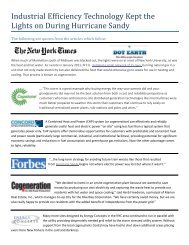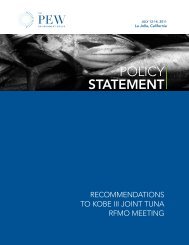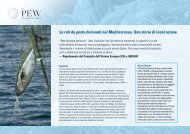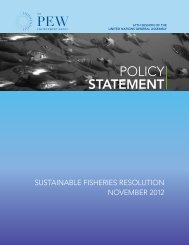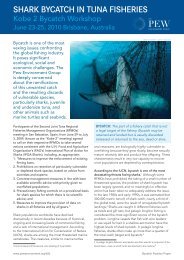GERMANY - The Pew Charitable Trusts
GERMANY - The Pew Charitable Trusts
GERMANY - The Pew Charitable Trusts
Create successful ePaper yourself
Turn your PDF publications into a flip-book with our unique Google optimized e-Paper software.
APPENDIX IV.<br />
COUNTRY PROFILE<br />
Germany<br />
Germany got to the front of the clean energy<br />
pack early and continues to be a top performer,<br />
thanks to its government subsidies and national<br />
policies. Although Germany obtained an early lead<br />
and has had significant deployment of renewable<br />
energy assets across the country, it is the only G-20<br />
member in which investments decline over the<br />
next decade under all policy scenarios. Under the<br />
enhanced policies scenario, for example, renewable<br />
energy investments in Germany decline 40 percent<br />
from 2010 to 2020. <strong>The</strong>se numbers reflect the<br />
reality that Germany has had major success<br />
in deploying clean energy assets domestically.<br />
Still, large amounts of capital will be invested in<br />
renewable energy in Germany over the next decade.<br />
In the enhanced policy scenario, the cumulative<br />
investment potential in Germany over the next<br />
decade is projected to be $208 billion, which would<br />
leverage installation of 80 GW of renewable energy<br />
generating capacity.<br />
Today, the country sources roughly 29 percent of<br />
its electricity from renewables, and is on a path to<br />
more than double their solar power generation by<br />
the end of 2010. Its generation-based programs and<br />
commitment to reduce its emissions at least 20<br />
percent from 1990 levels by 2020 have supported<br />
its booming renewable energy generation sectors.<br />
After years of success, Germany has begun to<br />
scale back the benefits of its feed-in tariff program,<br />
particularly in the solar sector where equipment<br />
prices are falling rapidly, making government<br />
support less needed. For wind, the country is<br />
nearing the saturation point for onshore projects,<br />
but opportunities remain for repowering existing<br />
projects with newer, more efficient equipment,<br />
and substantial potential offshore wind capacity<br />
remains. Still, Germany’s grid now experiences<br />
serious overloads in the northern parts of the<br />
country at times because of its large installed wind<br />
capacity. This issue has the potential to hamper<br />
Germany’s otherwise strong clean energy market if<br />
not properly addressed.<br />
<strong>The</strong> German government has for years placed<br />
economic growth and job creation at the heart<br />
of its push to scale up renewable energy, setting<br />
clear clean energy goals, and has a generous<br />
green stimulus program totaling $15.3 billion (the<br />
fourth highest worldwide). However, its clean<br />
energy equipment manufacturing industry, once an<br />
exporting powerhouse, has come under increased<br />
pressure from Asian competitors.<br />
Germany’s clean energy investment decline comes<br />
chiefly from a substantial drop in solar investment<br />
although it is compensated, in part, by a small<br />
increase in wind financing. <strong>The</strong> decline comes from<br />
two factors. First, the high levels of solar in Germany<br />
seen today are unsustainable in the long term as at<br />
some point demand will run out as the best sites are<br />
claimed. Second, costs could fall by 40 percent from<br />
2010 to 2020 due to experience curve effects. <strong>The</strong><br />
more frequently a task is performed or a product is<br />
made, the lower is the cost. So even if the number<br />
of solar installations in Germany remains stable,<br />
investment will fall as capital expenditure per watt of<br />
electricity falls.<br />
While most other countries could consider<br />
adopting new, more aggressive policies to promote<br />
renewables, Germany faces a different challenge.<br />
It is grappling with how to keep current subsidies<br />
cost-effective, given market dynamics. In the face<br />
of rapidly falling equipment prices, it will have to<br />
consider how to make sure that its feed-in tariff<br />
program tracks cost curves effectively to prevent<br />
a bubble of new installations. <strong>The</strong> program will<br />
continue to focus on distributed generation, offering<br />
the added incentive of having high local labor<br />
content that would make extending the incentives<br />
more palatable to Germans. As an additional<br />
incentive for distributed generation development,<br />
the country could offer tax breaks, public<br />
investment and new building standards for smallscale<br />
photovoltaic, biomass and energy efficiency.<br />
52 <strong>Pew</strong> <strong>Charitable</strong> <strong>Trusts</strong>
At the same time, Germany must address how its grid<br />
will manage an unprecedented load of renewable energy.<br />
One possibility would be to adopt smart grid technologies<br />
to integrate the distributed generation capacity evenly.<br />
Commercial-scale power storage projects could also help<br />
ease congestion. Finally, plug-in electric vehicles can<br />
play a similarly important role in power storage and allow<br />
further adoption of renewable capacity.<br />
Finance and Investment (2009)*<br />
Total Investment<br />
$4.3 billion<br />
G-20 Investment Rank 7<br />
Percentage of G-20 Total 3.7%<br />
5-Year Growth Rate 75.3%<br />
FIGURE 32. INVESTMENT IN RENEWABLE EN-<br />
ERGY ASSETS, 2020 (BILLIONS OF $)<br />
Germany<br />
20<br />
18<br />
16<br />
14<br />
12<br />
10<br />
8<br />
6<br />
4<br />
$12<br />
billion<br />
$13<br />
billion<br />
$18<br />
billion<br />
Installed Clean Energy (2009)<br />
Total Renewable Energy Capacity<br />
36.2 GW<br />
Total Power Capacity 29.0%<br />
Percentage of G-20 Total 14.6%<br />
5-Year Growth Rate 14.4%<br />
Key Renewable Energy Sectors<br />
Wind<br />
23,900 MW<br />
Solar<br />
7,757 MW<br />
Biomass<br />
3,631 MW<br />
2<br />
0<br />
Current Policy<br />
Copenhagen Policy<br />
Enhanced Clean<br />
Energy Policy<br />
Key Clean Energy Targets (2030)<br />
RE Heat<br />
Procure 14% of heating resource from<br />
renewable energy<br />
National Clean Energy Policies<br />
Carbon Cap<br />
Carbon Market 3<br />
Renewable Energy Standard 3<br />
Clean Energy Tax Incentives 3<br />
Auto Efficiency Standards 3<br />
Feed-in Tariffs 3<br />
Government Procurement 3<br />
Green Bonds<br />
RE Electricity<br />
Key Investment Incentives<br />
Wind, Solar,<br />
Biomass<br />
Renewable Energy<br />
Solar PV<br />
Procure 25% to 30% of electricity resource<br />
from renewable energy<br />
Feed-in tariffs<br />
Favorable credit terms with interest rates<br />
fixed in the 4% to 7% range<br />
Commercial installations exempt from VAT<br />
*Includes investments in venture capital and public markets, and asset finance for all clean energy technologies including biofuels<br />
and energy efficiency.<br />
Global Clean Power: A $2.3 Trillion Opportunity<br />
53



